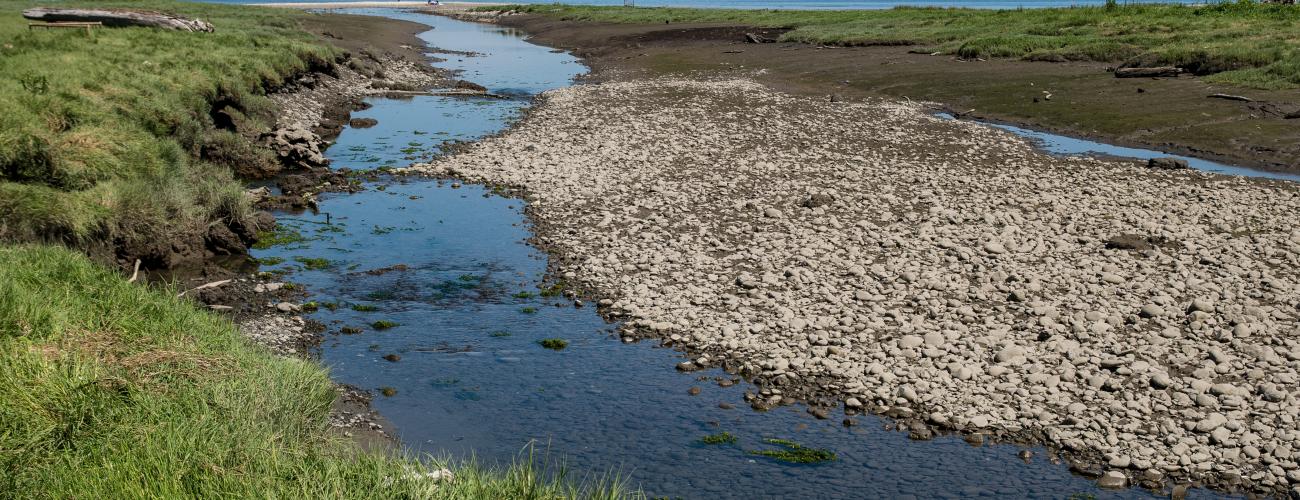Dosewallips State Park History
Between the Mountains and the Sea
Dosewallips State Park features extensive tidelands at the mouth of the Dosewallips River on Hood Canal. Erosion of the Olympic Mountains to the west combined with the steep gradient of the river carries a large quantity of sediment downriver. Silt, sand and gravel are deposited by the river when it reaches the flatter terrain in the park, naturally braiding its riverbed with many channels as it flows towards Hood Canal. The large fan of sediment and mud at the river’s mouth has long been a rich estuary. This habitat is of special importance for shellfish, including clams, oysters and geoducks.
Indigenous Lands
Dosewallips State Park lies within the traditional territories of Coast Salish people whose present-day descendants include members of the Skokomish Indian Tribe, Jamestown S’Klallam Tribe, Port Gamble S’Klallam Tribe, Lower Elwha Klallam Tribe, and Suquamish Tribe. For thousands of years the waters of Hood Canal and its tributaries have provided habitat for a diverse community of life that forms the basis of their cultures.
Local tribes ceded ownership of the area to the US federal government under duress in the Treaty of Point No Point in 1855, keeping rights to harvest natural resources in their usual and accustomed places, including the waters of Hood Canal. Government land surveys were completed in 1872. The survey map shows two distinct outlets to the Dosewallips River, an indication of the heavy load of sediment the river carried and the intricate estuary at the river’s mouth. After the survey, most of the land in today’s Dosewallips State Park was conveyed into private ownership as Cash Entry Patents, a type of sale of public domain lands, in 1873, 1875 and 1891. The land was utilized for timber harvest and shellfish production.
Izett Lumber Company
Much of the timber harvest was done by the Izett Lumber Company, based in Brinnon. James A. Izett, who also owned the Brinnon store and hotel, built a logging railroad between Brinnon and today’s park lands to access the timber by 1903. The operation featured “high lead yarding,” a technological advancement that had recently been invented by Oscar Wirkkala in the Willapa Bay area. High lead yarding employed steel cables running through a pulley placed at the top of a tall tree (called a spar tree), pulled by power winches called steam donkeys. This allowed felled logs to be moved to loading areas above ground, speeding the operation and causing less damage to the ground surface. It also made it possible to remove timber on steeper slopes.
Tragically, Izett died in 1913, at the wharf below his store. He had just learned how to drive and was loading his car onto a steamboat to ferry it to Seattle where his wife Mary was waiting to give birth to their first child. He cranked the car’s starter while it was in gear, it knocked him into the water and followed him in, drowning him.
Parts of the Steam Donkey Trail in today’s Dosewallips State Park follow the path of former logging railroad grades of the Izett Lumber Company.
Making a Park
The Washington State Parks and Recreation Commission (WSPRC) recognized the importance of securing public access to the extensive tidelands at the mouth of the Dosewallips River and their value for recreational shellfish harvesting. The WSPRC made the first purchase of property to create Dosewallips State Park in 1958. Day-use and camping facilities were soon added, and the new park was officially named on November 14, 1960.
Taking Care of the Land and Water
Facilities at Dosewallips State Park have been impacted by seasonal flooding, sometimes requiring closures to manage cleanup and repairs. Bank riprap was installed, and channels were dredged as protection, but these actions harmed the productivity of the estuary.
In 1989, shellfish harvesting was closed at Dosewallips State Park due to very high levels of fecal coliform contamination caused by a large population of harbor seals. Park staff designed and built fencing to exclude seals from a portion of the park and the protected tideflats were reopened to shellfish harvest in August 1993.
In 2003, the WSPRC joined the Hood Canal Coordinating Council and the non-profit Wild Fish Conservancy to begin the Dosewallips Estuary Restoration Project. Completed in 2022, the project restored river channel complexity and habitat in both the main stem of the Dosewallips River and the distributary channels in the estuary. Park campsites and infrastructure were relocated out of harm’s way. Levee setbacks, riprap removal, engineered log jams, tree planting on riverbanks, and saltwater dike removal allowed the restoration of natural systems that will improve fish habitat for threatened summer chum and Chinook salmon for many years to come.
Sharing the histories of Washington’s state parks is an ongoing project. Learn more here.

